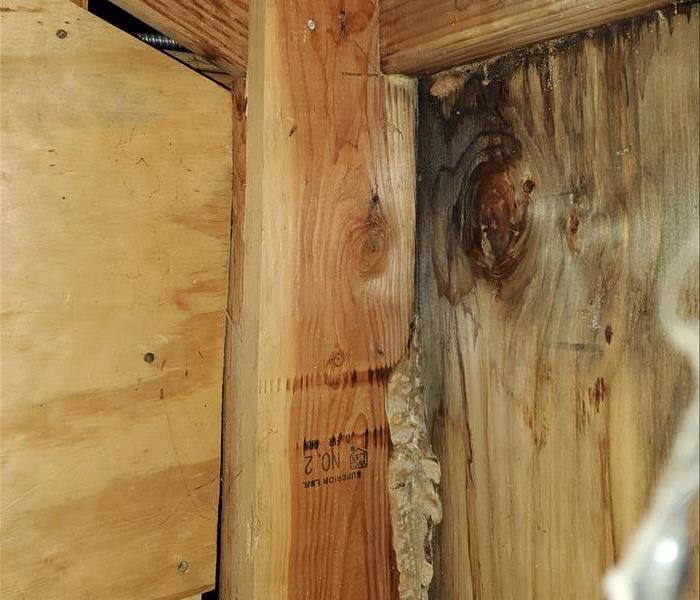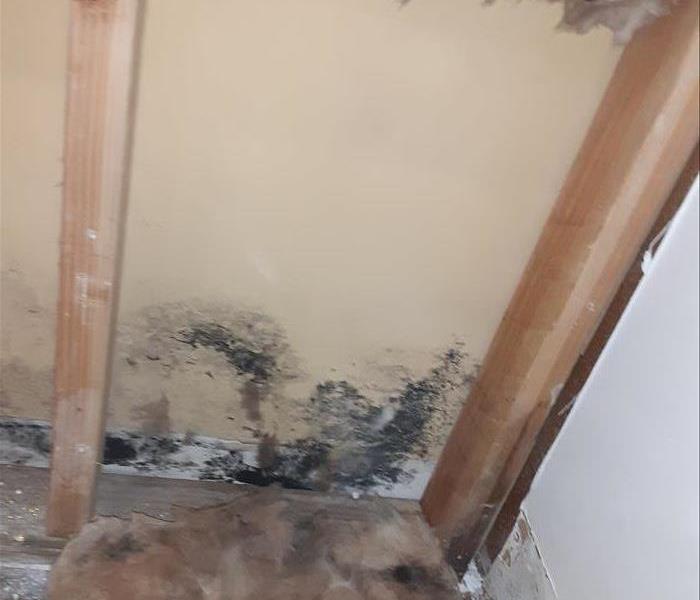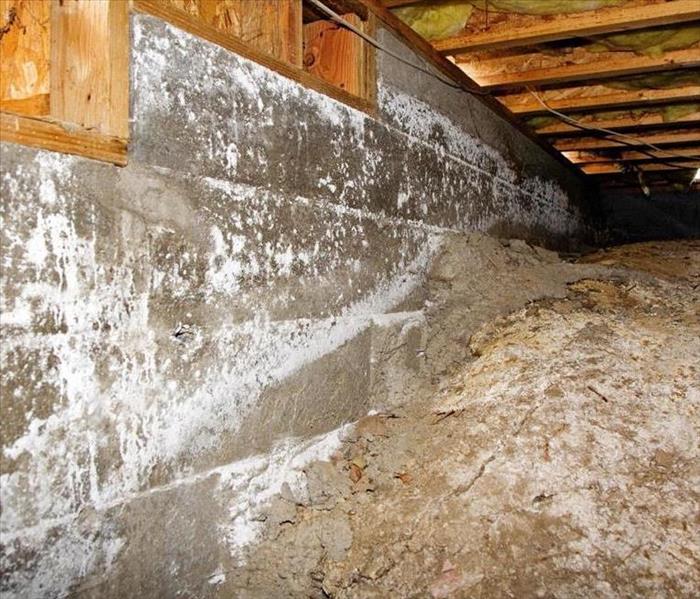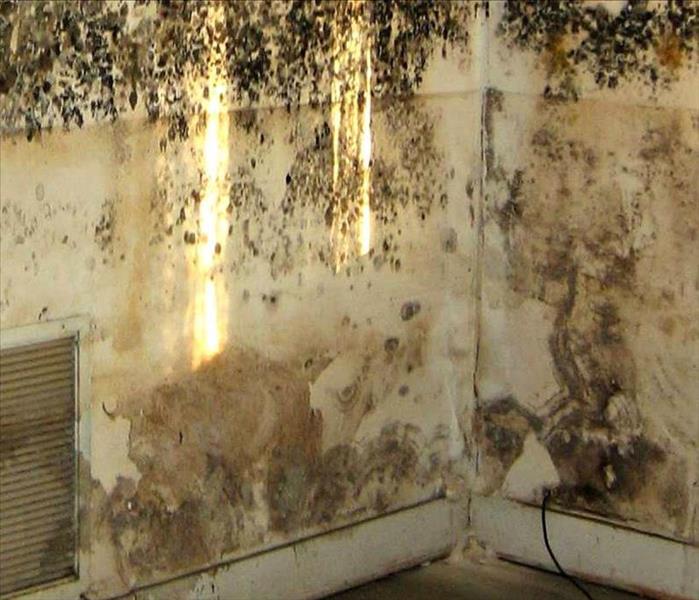Archived Mold Remediation Blog Posts
Step-by-Step Mold Remediation with SERVPRO
3/6/2025 (Permalink)
 Close-up of mold growing on a wall with dark spots, indicating moisture damage and potential health risks.
Close-up of mold growing on a wall with dark spots, indicating moisture damage and potential health risks.
Every business’s mold damage situation is unique and may require a tailored solution. However, the general mold remediation process remains the same. The steps outlined below represent the “typical” process:
Step 1: Emergency Service
Contact SERVPRO of Northwest Ventura County at 805-507-5507 for immediate assistance.
Step 2: Inspection and Assessment
Our team conducts a thorough evaluation to assess the extent of the mold damage.
Step 3: Mold Containment
We isolate the affected areas to prevent the spread of mold spores.
Step 4: Air Filtration
We use advanced air filtration systems to capture airborne spores and improve air quality.
Step 5: Removing Mold and Mold-Infested Materials
We carefully remove contaminated materials to stop the mold from spreading further.
Step 6: Cleaning Contents and Belongings
All affected items are professionally cleaned and restored to prevent mold growth.
Step 7: Restoration
We restore your property to its original condition, ensuring all mold damage is addressed.
Need Help? Call SERVPRO of Northwest Ventura County
We’re available 24/7, 365 days a year. Call us at 805-507-5507 for fast, professional mold remediation.
Mold and Water Damage Restoration: A Comprehensive Approach
7/18/2024 (Permalink)
Water damage can have far-reaching consequences for indoor environments, often leading to mold growth if not addressed promptly and effectively. Mold thrives in damp, moist conditions, making water-damaged areas particularly susceptible to contamination. As such, mold and water damage restoration require a comprehensive approach that addresses both the immediate effects of water damage and the potential long-term consequences of mold growth. In this blog, we'll explore the interconnected nature of mold and water damage restoration and discuss strategies for a comprehensive restoration approach.
Understanding the Link Between Water Damage and Mold Growth
Water damage provides the ideal conditions for mold growth, creating a humid environment where mold spores can germinate and proliferate rapidly. When water infiltrates indoor spaces due to flooding, leaks, or plumbing failures, it can penetrate building materials such as drywall, wood, and insulation, creating hidden pockets of moisture conducive to mold growth. Without prompt mitigation and remediation, water-damaged areas can become breeding grounds for mold, leading to contamination of indoor surfaces and compromising indoor air quality.
The Importance of Swift Water Damage Mitigation
Effective water damage restoration begins with swift mitigation efforts to remove excess water and moisture from indoor spaces. This involves extracting standing water using pumps or wet/dry vacuums, drying affected surfaces with industrial-grade dehumidifiers and air movers, and implementing measures to prevent further water intrusion. Swift mitigation helps minimize the extent of water damage, reduces the risk of mold growth, and sets the stage for effective mold remediation.
Mold Remediation: Addressing Hidden Contamination
Even after water damage has been mitigated, residual moisture and dampness may persist in building materials, creating favorable conditions for mold growth. As such, mold remediation is an essential component of comprehensive water damage restoration. Mold remediation involves identifying and removing mold-contaminated materials, cleaning and disinfecting affected surfaces, and implementing measures to prevent mold recurrence. Professional mold remediation specialists such as SERVPRO of Northwest Ventura County have the expertise and equipment to conduct thorough inspections, assess the extent of mold contamination, and implement targeted remediation strategies to restore indoor environments to a safe and healthy condition.
Integrated Restoration Solutions
To ensure a comprehensive approach to mold and water damage restoration, it's essential to integrate mitigation, remediation, and restoration efforts seamlessly. This may involve:
- Assessment and Inspection: Conducting thorough assessments to identify water damage and mold contamination, including hidden areas such as behind walls, under flooring, and within air ducts.
- Swift Mitigation: Implementing rapid water extraction and drying techniques to remove excess moisture and prevent mold growth.
- Professional Remediation: Engaging certified mold remediation specialists to conduct comprehensive mold inspections, remediate contamination, and restore indoor environments to preloss conditions.
- Repair and Restoration: Repairing and restoring water-damaged materials and structures to their original state, ensuring structural integrity and aesthetic appeal.
Prevention and Maintenance
In addition to remediation efforts, proactive prevention and maintenance measures are essential for preventing future water damage and mold growth. This may include regular inspections, maintenance of plumbing and HVAC systems, implementation of moisture control measures, and establishment of effective drainage and waterproofing systems.
The Hidden Dangers of Mold in Air Ducts
3/13/2024 (Permalink)
Let's discuss a silent intruder that might be lurking in your home – mold in your air ducts. Since our air ducts are out of sight and out of mind, most of us don't give much thought to our HVAC systems until something goes wrong, but understanding the hidden dangers of mold in air ducts is crucial for maintaining a mold neutral living environment.
The Sneaky Culprit
Mold is a persistent little troublemaker that can find its way into your air ducts without much fanfare. It thrives in dark, damp environments, making your HVAC system an ideal breeding ground. From airborne spores, it settles in the ducts, and can spread throughout your home or business, forming colonies that can lead to a variety of issues.
Reduced Efficiency
Mold growth in air ducts can also hinder the efficiency of your HVAC system. Mold buildup restricts airflow, making your system work harder to maintain the desired temperature. This not only increases energy consumption but can also lead to premature wear and tear on your HVAC components.
Unpleasant Odors
Ever noticed a musty odor when your HVAC system kicks in? That's a telltale sign of mold in your air ducts. Mold produces volatile organic compounds (VOCs) that contribute to that distinctive, unpleasant smell. Eliminating the mold means saying goodbye to those unwelcome odors.
Prevention and Remediation
The good news is that preventing and addressing mold in your air ducts is well within reach. Regular HVAC maintenance, including cleaning and inspecting your ducts, can help identify and eliminate mold before it becomes a serious problem. Additionally, investing in quality air filters and maintaining proper ventilation in your home can go a long way in keeping mold at bay. Remember, mold thrives on moisture, so minimize the moisture in your home and air ducts as much as possible.
When to Call the Pros
If you suspect mold in your air ducts or have noticed a decline in indoor air quality, it's time to call in the professionals. SERVPRO® specializes in mold remediation and can safely and effectively eliminate mold from your air ducts, restoring a clean and mold neutral environment for you and your family.
Don't let mold hide in the shadows of your air ducts! By understanding the hidden dangers and taking proactive steps, you can ensure your HVAC system operates efficiently while keeping your home's air quality top-notch. Remember, a healthy home is a happy home!
Mold Removal vs. Mold Remediation: What's the Difference?
10/24/2023 (Permalink)
 When dealing with mold issues in your home or business, it's vital to choose the right approach.
When dealing with mold issues in your home or business, it's vital to choose the right approach.
Mold is a common problem for homeowners and business owners alike. When you discover mold in your property, it's crucial to understand the difference between mold removal and mold remediation. These terms may seem similar, but they encompass distinct processes with varying levels of effectiveness. In this blog, we will clarify the distinction to help you make informed decisions when dealing with mold issues.
What is Mold Removal?
Mold removal, often referred to as mold cleaning or mold mitigation, involves the physical removal of visible mold from surfaces. It typically includes cleaning and scrubbing the affected area to eliminate the visible mold growth. While this approach can make the mold disappear temporarily, it does not address the root cause of the issue, which is moisture. Mold can easily return if the moisture problem isn't resolved.
The Limitations of Mold Removal:
Temporary Solution: Mold removal offers a short-term fix, as mold may reappear if the underlying moisture issue persists.
Surface-Level: It primarily targets the visible mold growth on surfaces, neglecting hidden mold in walls, ceilings, or under flooring.
Limited Prevention: Mold removal alone doesn't take proactive measures to prevent future mold growth.
What is Mold Remediation?
Mold remediation is a comprehensive process that goes beyond mold removal. It focuses on identifying and addressing the source of moisture that sustains mold growth, along with the removal of mold colonies. This approach ensures that mold is not only removed but also prevented from returning.
The Benefits of Mold Remediation:
Effective Solution: Mold remediation offers a more effective and long-lasting solution by addressing the root cause – moisture.
Thorough Inspection: It involves a thorough inspection of the property to locate hidden mold, allowing for complete removal.
Preventive Measures: Mold remediation includes moisture control, ventilation improvements, and preventative actions to deter future mold growth.
Why Choose Mold Remediation Over Mold Removal?
Comprehensive Approach: Mold remediation is a holistic approach that provides a lasting solution by eliminating the conditions that promote mold growth.
Improved Indoor Air Quality: It helps to enhance indoor air quality by removing mold spores and contaminants.
Property Value: Proper mold remediation can maintain or even increase the value of your property, as it ensures a mold-free environment.
When dealing with mold issues in your home or business, it's vital to choose the right approach. Mold removal is a temporary fix that focuses solely on the visible mold, while mold remediation is a comprehensive solution that addresses the underlying moisture problem and prevents future mold growth. For effective and long-lasting results, it's advisable to opt for professional mold remediation services.
At SERVPRO® of Northwest Ventura County, we specialize in mold remediation, ensuring a safe and healthy environment for your property. If you have any mold-related concerns or require our expertise, don't hesitate to contact us for a consultation. Your property deserves the best care when it comes to mold issues.
Understanding Mold
4/8/2019 (Permalink)
 Mold in a crawl space in Venura, CA.
Mold in a crawl space in Venura, CA.
MOLD...
How did it get here?
Mold can grow by digesting and destroying the material the spores are on. Mold spores can be found almost anywhere and can grow on just about any material as long as conditions are right. Mold needs oxygen, a source of moisture, and a boidegradable material to grow on. Molds reproduce by making spores. These spores can become airborne. If airborne spores land on suitable material and conditions are favorable, the mold will begin to grow within 48-72 hours.
Even though mold spores can be found everywhere, they become a problem when they begin to grow indoors. Many building materials such as drywall, ceiling tiles, and wood framing are materials on which molds can and do grow. As molds grow on building materials they may become destructive rapidly. Molds may grow unnoticed for some time. They hide in & above ceilings, behind walls, in attics and basements or in crawl spaces. Molds can cause staining of walls and ceilings and can begin to break down the studs and joists of buildings causing extensive property damage.
Excessive moisture is a key ingredient which causes molds to grow. Sources of excess moisture may be plumbing leaks, leaking appliances, roofs or windows, high humidity, flooding, or condensation inside walls due to poor insulation.
SERVPRO of Northwest Ventura County has 24 years of Mold Remediation experience and knows exactly how to help get mold under control.
Call us today for a free inspection. 805-507-5507
If You Have Mold Call SERVPRO Today
11/1/2018 (Permalink)
 Mold Damage mitigation in Ventura, CA
Mold Damage mitigation in Ventura, CA
If your home or business has a mold problem, we can inspect and assess your property and use our specialized training, equipment, and expertise to remediate your mold infestation quickly.
Every mold damage scenario is different and requires a unique solution, but the general mold remediation process stays the same. The steps listed below illustrate the “typical” process:
Step 1 : Emergency Service contact SERVPRO of Northwest Ventura County
Step 2 : Inspection and Mold Damage Assessments.
Step 3: Mold Containment.
Step 4: Air Filtration.
Step 5: Removing Mold and Mold infested Materials.
Step 6: Cleaning Contents and Belongings
Step 7: Restoration
With 23 years of expertise you are in good hands
If You See Signs of Mold, Call Us Today – SERVPRO of Northwest Ventura County 805-507-5507
24/7/365
 Close-up of mold growing on a wall with dark spots, indicating moisture damage and potential health risks.
Close-up of mold growing on a wall with dark spots, indicating moisture damage and potential health risks.





 24/7 Emergency Service
24/7 Emergency Service


